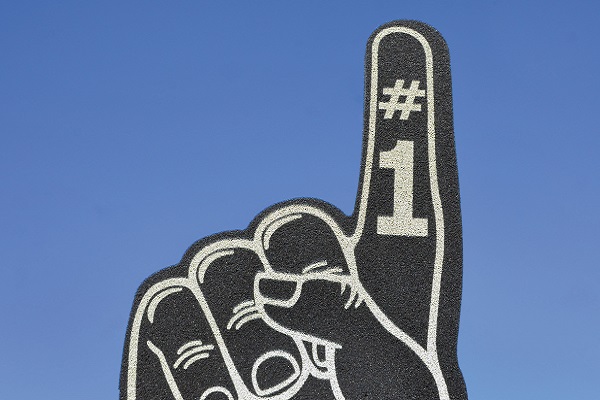Creating Superfans: Share Your Origin Story to Turn Customers into Advocates

By: Brittany Hodak
The easier it is for a customer to get something similar to your product, the better their experience must be with you. Otherwise, you’ll be seen as a commodity and lose on price, speed or any other variable customers can compare directly across competitors.
Don’t lead with features and benefits. Instead, create a differentiated experience right off the bat with an impactful story. Once a customer has an emotional point of connection, your competitors won’t stand a chance.
Storytelling is all about positioning: the space we take up in our customers’ minds. If you aren’t clear on where that space should be, they won’t be, either. Your story helps define your position by answering questions about what you’re the best at and why that matters.
Where do you want to live in your prospects’ and customers’ minds? When do you want them to think about you and why?
Answering these questions will help unlock one of our most powerful tools: a story that will be valued, remembered and shared.
Our brains are hardwired to remember and react to stories. This evolutionary truth has played a role in oral histories that have been passed down over millennia. It can also help savvy marketers and salespeople close deals by expertly setting the stage for their customers.
One of the first questions I get when I say, “start with your story” is this: Are you talking about the brand story or the individual employees’ stories?
The answer? Both. Because much like the Chicago Bulls and Michael Jordan, they are intrinsically linked. One is a key character in the story of the other, just as each employee is a character in the story of your brand as it plays out in real time.
If you’re a founder or solopreneur, there will be a lot of overlap in the story between you and your agency. However, it’s important for each employee to be able to explain how and why they got to the position they’re in. It’s tantamount to being able to show that they care—because if your employees are apathetic, your customers will be, too. One of the best ways to connect the dots between a brand and its employees is with employee origin stories.
I’m a proponent of every employee at a company building their personal brand. Not only does it help the individual, it also helps the company. Think about it: People buy from people. Why wouldn’t you want your people to be perceived as the very best? It helps your entire agency build its reputation as a category leader. Origin stories are a powerful way to accomplish this goal.
Let’s Talk About Me
You can take creative license to connect the dots between the meaningful moments from your past and where you’re at now. The finished product will be a memorable story that helps people say, “I get it!” and “That’s who I want to work with,” whether you’re the longtime leader or the new kid on the block.
Here’s an example of how I positioned my origin story when I worked in advertising:
Position: Advertising agency executive.
Key role: Winning and keeping brand clients for the agency.
Audience: Brand managers and C-level executives.
I wanted to work in advertising before I even knew what “advertising” meant. While my cousins were annoyed by commercials during our favorite Saturday morning TV shows, I was mesmerized by them: I loved the cadence of the jingles, the poetry of the slogans and the intricate stories that could be told in 30 or 60 short seconds. I can still hear every word of the “My Buddy” and “Kid Sister” jingles and see the Kool-Aid Man busting through brick walls.
My parents hated taking me to the grocery store because I would insist they buy the brands whose ads resonated with me. I’m not just talking about shunning the cereals that didn’t have memorable mascots—I would make impassioned, mid-aisle scenes about everything from cold cuts to condiments based on store signage or ads I’d seen, pleading: “After all, it’s Butterball!”
It wasn’t just ads, either: I was—and still am—obsessed with product packaging. My mom still tells the story of how she came into the bathroom to check on me when I was about 7 years old and had been in the tub for a long time. The problem? I was stuck in a seemingly endless loop of washing my hair because of the words “rinse and repeat” printed on the back of the new Pantene bottle. Every time I rinsed, I repeated.
When I look back, it’s not surprising that my obsession led me to a career in advertising. That love sparked my decision to attain a master’s degree in marketing with a focus on shopper marketing and consumer behavior. I wanted to be part of the elite club of people whose job is to make consumers fall in love with products through clever, carefully designed campaigns.
Cute story, right? Hopefully, it evokes images of a precocious little girl whose love of advertising took her from rural Oklahoma to Madison Avenue. Let’s talk about a few of the intentional decisions I made when crafting this story.
First, it references specific brands and products, like Pantene, Butterball and Kool-Aid. This is important because my target audience at the time was focused on building their own brands and each reference was an opportunity to connect with them. Hopefully, the audience would have their own fond memory of one of the brands mentioned in this story and, on a subconscious level, would feel closer to me because of our shared experiences.
Second, the story includes a memorable, self-deprecating anecdote. The depiction of me as a confused, very literal 7-year-old is a story people will remember. When choosing key snapshots to include in your origin story, consider humorous ones that allow the listener to get a quick laugh at your expense. Don’t ever make a joke at the expense of your prospects or customers, though, or you might come across as arrogant or mean. Pro tip: Making fun of your target audience is never a good strategy!
Third, I get to tout my credentials—a master’s in marketing with a focus on consumer behavior—in a way that doesn’t seem forced. Because many of the brand managers whose business I was trying to win had MBAs, I knew dropping a quick mention of my degree was relevant. Think about what credentials matter to your target audience and find a way to weave them in organically. Last, I make references to family members because my target audience was largely women trying to sell products to other women shopping for their households. These story snapshots were designed to connect and endear me to them.
Did I ever tell that story word for word? No, but mapping it out helped me draw a direct line from my past to my current role and shaped the way I introduced myself to my peers and prospects. It will do the same for you and your employees. Writing and then internalizing that story enabled me to pull out those details strategically over the course of conversations almost automatically and introduce opportunities for commonalities. Read: Connecting my story with their story—more quickly.
Likewise, this origin story was useful as I pitched clients to win new business, as were the other dozen or so vignettes I plucked from my past to recite as appropriate to help illustrate why I was the perfect partner for whatever business opportunity I was vying to win. The purpose of any story is to connect with the audience.
I wasn’t a founder at the advertising agency. I wasn’t even in the C-suite. It didn’t matter; I still needed a strong origin story because every employee represents the company. My prospects and customers wanted to get to know who they would be working with on their account. Your customers are no different. Whether an origin story is being conveyed in an instant—like a hometown printed on a cashier’s name tag—or over coffee, sharing details from your life leads to deeper-felt connections.
(What’s the Story) Morning Glory?
When I was teaching a workshop on origin stories at the 2021 Big “I” Young Agents Leadership Institute for a group of insurance professionals, a man told me that he’d been inspired to start a career in insurance because of a pivotal moment in his childhood: A flood in his small hometown destroyed the general store his family had owned and operated for generations.
It was the only time he saw his grandfather or father cry. On one stormy night, the family lost everything. And, because they didn’t have flood insurance, they were left to rebuild with very little help. They hadn’t even realized the store was in a flood zone and no one had ever talked to them about the need for a separate flood insurance policy.
He’d been drawn to insurance to help ensure that the tragedy that struck his family wouldn’t be repeated. The craziest part? He’d never told a customer or prospect his story before. “I just never thought much about it,” he said. “I didn’t realize how relevant it was. But, you’re right, customers would probably like to hear that story.”
Of course they would! That origin story catapults his job from profession to purpose. It takes him from a commodity seller to a category of one. Your origin story will do the same, regardless of the role you’re playing in your organization.
So, what is your insurance story? Why are you proud to be an independent agent? And what superpower do you bring to the office every day?
Are there connections you’re noticing now in your own life that you never thought about before? Perfect, because an origin story is just the beginning.
This article is an adapted excerpt from “Creating Superfans” by Brittany Hodak. Order or download the book and find out how to turn your customers into lifelong advocates here.
Hodak is an award-winning entrepreneur, author, and customer experience speaker who has delivered keynotes across the globe to organizations including American Express and the United Nations. She has also developed successful campaigns and products for globally known brands including Walmart, Disney, Amazon, Katy Perry, the Boston Red Sox and more.










